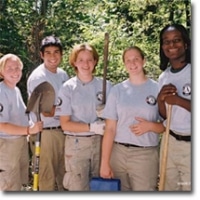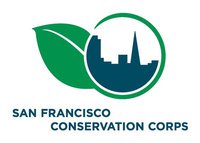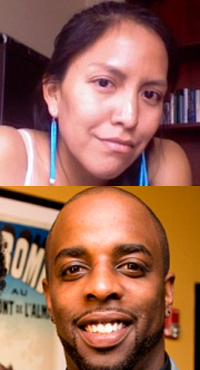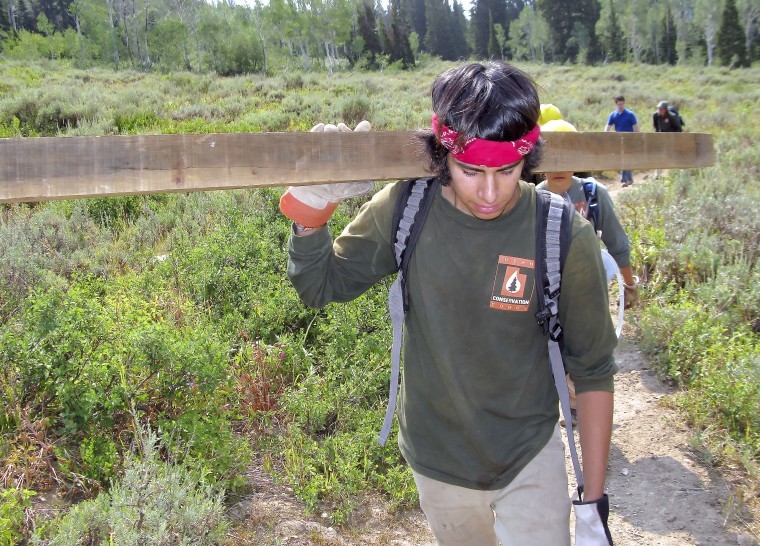National Service: An Imperative in Today’s Economy

President, Voices for National Service; Chief Strategy Officer and Executive Vice President, City Year, Inc.


Father John Wandless named his program the Urban Ranger Corps based on the philosophy that the participants “all live in the urban core and care for the environment around them — the yards and homes of their neighborhoods — like forest or park rangers.” This summer 58 Urban Rangers have spent seven weeks cleaning up trash and old tire strewn lots, shoring up or tearing down sagging porches and rebuilding them as decks or patios; patching and caulking holes in exterior walls and painting houses, building fences, mowing yards and trimming or cutting down overgrown trees and bushes. Work was completed for low-income homeowners, with particular focus on eldery persons and single parent households. The 32-hour work week and 4-hour weekly workshop sessions give the teens work experience and training and earn them a bi-weekly check that pays them up to $2,400 for the summer, for many of the young men, their first paycheck. Fund raising helps purchase equipment and tools and pays their wages. Read more here in an article by Marty Denzer of the Catholic Key Reporter.

After three months of hard and rewarding work, San Francisco Conservation Corps Corpsmembers have completed the Buena Vista Project. SFCC partnered with the San Francisco Recreation and Park Department’s Capital Division to identify and area of erosion and safety concern in the oldest park in San Francisco, the Buena Vista. Their work included deconstruction and re-building of stairways and retaining walls. See a slide show about their work here.

Dorothy Stoneman, founder and CEO of YouthBuild USA, Inc. (one of our partners in the National Council of Young Leaders) speaks to the role of youth-serving organizations in addressing challenges faced by Opportunity Youth in a recently published article on the Huffington Post called “Solutions are Obvious for a National Emergency”.

The Corps Network’s Clean Energy Corps program was featured this week on the Huffington Post in an article written by Interim CEO Mary Ellen Ardouny. The article explains how this youth development program, funded by AmeriCorps and operated in nine Corps, is making a difference.
She writes: “When we envisioned the program several years ago, we thought it would be an excellent way to engage Corpsmembers in work that would lead to credentials and careers, while at the same time saving energy and money for residents in their communities. I’m pleased to report that after nearly two years, the program has proven successful.”
In a recent six month period, the Clean Energy Corps weatherized and retrofitted 493 homes, of which 98 percent showed reduced annual energy usage based on pre and post-test data. In this same six month period, 3,510 households were informed about energy and cost-saving strategies and 746 additional community volunteers were mobilized on service projects.
But perhaps the biggest benefit comes to the Corpsmembers themselves. They receive credentials like the Building Performance Institute (BPI) Insulation/Air Sealing Technician certification, which allow them to more competitively pursue careers in the growing green energy industry.
Corps currently participating are American YouthWorks, CivicWorks, Green City Force, Heart of Oregon,Limitless Vistas, SEEDS, Chenango Community Corps, The Sustainability Institute/Energy Conservation Corps, and Youth Conservation Corps.

Photo by Eli Lucero – Herald Journal
“Youth corps introduces uninitiated to great outdoors”
TONY GROVE — On a bright Wednesday morning just before 9 a.m., Tony Grove is virtually silent, save for a few birds chirping and the gentle gallop of horseback riders off in the distance.
But only a half hour later, a group from the Utah Conservation Corps Bilingual Youth Corps have arrived — doing some stretching, laughing, and then preparing for a 4-mile hike into the wilderness terrain to White Pine Lake.
Their gear includes yellow hard hats, boots, axes, shovels, and backpacks stuffed with food and water. And who can forget their uniforms: A pine green shirt spotting the UCC logo.
“OK, off like a herd of turtles,” said Kate Stephens, program director for the Utah Conservation Corps, as the 12-member group headed up the path that would lead them to the lake.
The trip was part of the final week of a five week session of Bilingual Youth Corps, an extension of the Utah Conservation Corps, which is under the USU AmeriCorps. The final week of the session is conducted entirely outside, and for that week, the group was assigned to put up signs and repair existing ones in the White Pine Lake area.
Founded in 2008, Bilingual Youth Corps is now in its fourth year.
“The Latino population had exploded over the last decade,” Stephens said in an interview on her reason for founding the youth corps. “The Latino community does not recreate as much on our public lands — generally, it’s just not a part of their culture — so this was an opportunity to reach out. ”
She continued, “We wanted our UCC to be representative of a changing demographic in Logan.”
Read more about this innovative program and this project here.

They traveled 2,000 miles from home, trading high-rise buildings for towering trees, city lights for twinkling stars, and an urban cacophony for the melodies of songbirds.
Relaxing? Hardly. These six Baltimore teenagers aren’t on vacation. They are working long, hard days to restore the wilderness character of Carson National Forest in New Mexico.
All six are members of the Student Conservation Association (SCA), a national nonprofit organization that engages young adults in hands-on conservation to build connections with nature and provide career skills and training. In June and July, the crew members worked in urban parks back home in a pioneering SCA program that employs under-represented city youth in green summer jobs near their own neighborhoods. When given the option of performing similar work in a national forest, the teens jumped at the chance.
“There’s not many wide open places like this left, so we have to do what we can to protect them,” says 17-year-old Malik Moore. “Plus, I get to go out West for the first time. No way was I going to pass this up.”
None of the SCA team had ever traveled this far before; few had even been more than a few miles from home. During the day, they build hiking trails, restore campsites, and remove invasive plants before heading to basecamp to prepare their own meals over an open fire, take in environmental lessons from their crew leaders, and retreat to their tents for a restful sleep. “This is an adventure, no doubt about it,” states Howard Thorne, Jr. “But we all know why we’re here. There’s work to do.”
The project is part of the Forest Service’s 10-Year Challenge to achieve specific stewardship objectives at more than 400 US Forest Service sites by 2014, the 50th anniversary of the Wilderness Act. S. Elwood York, Jr., the Forest Service’s wilderness program leader in Washington, D.C., says he also had another objective in mind in creating the Carson opportunity for the SCA Baltimore crew.

Cherokee, NC – Oconaluftee Job Corps Civilian Conservation Center joined 125 other Job Corps centers across the country to celebrate the second annual ‘National Job Corps Commencement Day’. Held on Friday August 24th, 2012, the local ceremony congratulated 20 students who graduated the program this year with successful education and career training in everything from Forestry Conservation to Office Administration.
At the Oconaluftee JCCCC, these young adults aged 16-24 were offered a set of diverse academic opportunities and career pathways tailored to meet the needs of today’s business and industry. Nationally each year, thousands of youth are given a second chance to complete their education and advance into careers, higher education or the military. Program graduates then return to their local area as active contributors to the economic and social fabric of the community much like the original CCC work programs of the 1930’s. US Senator (D-NC), Kay Hagan, wrote to Oconaluftee’s graduates “I don’t have to tell you that our country is facing hard economic times. This day showcases to the community, employers, and tax payers that the Job Corps program is one of the nation’s most effective career preparation programs… our focus must once again be on progress and job creation.”

From the Colorado Youth Corps Association
When Justin Quintana-Scott’s home in Beulah, Colo. was destroyed in a fire in January 2012, he lost not only his house, but his two dogs as well. The mountain community of Beulah came forward in support by holding a fundraiser and erecting a memorial – gestures Justin will never forget. He is repaying his community’s kindness in part through his involvement with Mile High Youth Corps-Pueblo.
“I saw how my community stepped up and pulled together to help us out. It inspired me to help more,” says Justin, who joined Mile High Youth Corps in June.
A member of the Apache and Navajo Indian tribes, Justin is a sophomore at Colorado State University in Pueblo. He is studying wildlife biology (he made the Dean’s List this year) and has dreams of working for the Division of Parks and Wildlife.
He is getting valuable work experience through youth corps, building on an innate interest in the outdoors. “I’ve always been around wildlife – including bears, deer and mountain lions. I’d like to work closely with wildlife, and make it so that the next generation will have access to that too,” he says.
Justin’s crew is braving the scorching Colorado temperatures clearing corridors along the Arkansas River Trail and the Fountain Creek River Trail. By ridding the area of Russian olive trees – an invasive species and daily consumer of more than 30 gallons of river water – Mile High Youth Corps is “making the Pueblo nature scene more friendly to the public and pleasing to the eye.”
Justin is working toward an AmeriCorps scholarship to help pay for college. To achieve his goal, he needs to complete 300 hours of work with the youth corps. But to Justin, this is more than just work. “We’re always smiling, not because it’s a job, but because everyone on my team wants to be there.”
Justin and his family are rebuilding their life with a new house in Pueblo, and he is setting an example for youth with a positive outlook. “I like that in youth corps, we’re helping out the community and setting a positive role model for the youth of Pueblo. It’s altogether fun and enjoyable, and makes me feel good to be a positive influence.”

Our friends at Young Invincibles have released a new policy brief titled “Young America Ideas Book: 12 Solutions to Help Get Our Generation Back on Track.” You can download the publication here.
A press release from Young Invincibles explains that “These ideas are not designed to be comprehensive solutions, but rather provide concrete, pragmatic steps that our political leaders can take right now to address the economic problems facing young people. The 12 solutions are based on discussions with young adults across the country, available data, and expert opinion.
Policy ideas include:
1. Create 500,000 AmeriCorps jobs, so that young adults can serve our country and get valuable work experience. Last year, 500,000 people applied for 80,000 positions.
2. Establish the “American Counseling Fellows” program to send 30,000 recent college grads into high schools to assist under-staffed school counselors in career and college counseling; like Teach for America for school counselors.
3. Require disclosures on all TV college advertisements where schools must publish their employment rates after graduation.
4. Student loan repayment programs made easy and pumped-up financial aid counseling to help students make good decisions and repay student loans.